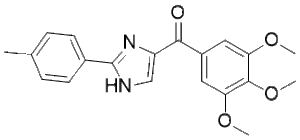This product is for research use only, not for human use. We do not sell to patients.

| Size | Price | Stock |
|---|---|---|
| 5mg | $500 | 3-6 Days |
| 10mg | $850 | 3-6 Days |
| 25mg | $1600 | 3-6 Days |
| 50mg | $2800 | 3-6 Days |
Cat #: V41098 CAS #: 1253697-93-6 Purity ≥ 99%
Description: ABI-274 is a novel, orally bioavailable, highly potent and selective tubulin/mitotic inhibitor (specifically a microtubule destabilizer) targeting the colchicine binding site, belonging to the so called colchicine binding site inhibitor (CBSI). It has shown potent anticancer activities in vitro and in vivo, as well as favorable pharkacokinetics such as good oral bioavailability.
Publications Citing InvivoChem Products
Product Promise

- Physicochemical and Storage Information
- Protocol
- Related Biological Data
- Stock Solution Preparation
- Quality Control Documentation
| Molecular Formula | C20H20N2O4 |
|---|---|
| CAS No. | 1253697-93-6 |
| SMILES Code | O=C(C1=CNC(C2=CC=C(C)C=C2)=N1)C3=CC(OC)=C(OC)C(OC)=C3 <br/> |
This equation is commonly abbreviated as: C1 V1 = C2 V2
- (1) Please be sure that the solution is clear before the addition of next solvent. Dissolution methods like vortex, ultrasound or warming and heat may be used to aid dissolving.
- (2) Be sure to add the solvent(s) in order.




































